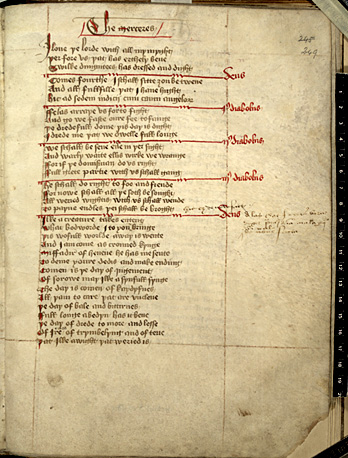
With the fourteenth and fifteenth centuries, we move into the world of the workaday scripts used by scribes for documents, accounts, and less prestigious works of literature and devotion for which there is an increasing market as ordinary people become more and more literate. These scripts come from a variety of sources, evolved for different uses: Cursiva Anglicana is the script, based on Early Gothic, used by English civil servants; Secretary is a spiky version with high pointed looped ascenders, probably adopted from France, used for documents and letters and also very popular for literary and devotional works; Anglicana is the downmarket English version of Gothic Textura used for less expensive books.
They are all 'joined-up writing', with a tendency to extravagant loops on the ascenders. They also developed distinct letter-forms, such as g, d, r, and a, the 'back-to-front' e,and the 'Danish-pastry' s, and English letters like k and w, which have been around but in vernacular manuscripts, appear at last. The 'Anglo-Saxon' letters þ ('th') and 3 ('yogh' - unfortunately I cannot find a proper font for it which is installed on all Web browsers, so have to use 3) are also used: þ is often indistinguishable in shape from y.
Use the original letters when transcribing: do not convert to th and y/gh/z, or you could get in a mess.
Scribes used to writing Bastarda or Textura may have a preference for certain letter-forms from these scripts, or try to approximate their work to their general overall aspect. Palaeographers can distinguish and label a grand variety of hybrids, such as Secretary Anglicana or Bastard Secretary. The important thing here is to learn to read them: at first they will seem more challenging than anything you have met so far, but you soon get your eye in.
This is folio 249r from British Library Additional MS 35290 , the York Register of the Corpus Christi Play, known more familiarly as the York Cycle of mystery plays. This was written somewhere between 1463 and 1477 by several hands. This is Scribe B, who wrote most of the text in a blend of Secretary and Anglicana. Scribes were not accustomed to play scripts, and had only recently evolved a method of presenting them.

| 1.....Transcribe it. .......I have transcribed the first two speeches as a starter. .......Go to the following pages for a close-up version in slices. | Feedback |
| 2.....Copy out a line, using pen and ink. What do you notice about the mechanics of writing? | |
| 3.....Describe it in terms of | |
..A..... Overall aspect; | Feedback |
..B..... Individual letter forms. | Feedback |
| 4.....Describe the layout. | Feedback |
Return to Index Page.
© MEG TWYCROSS 2000